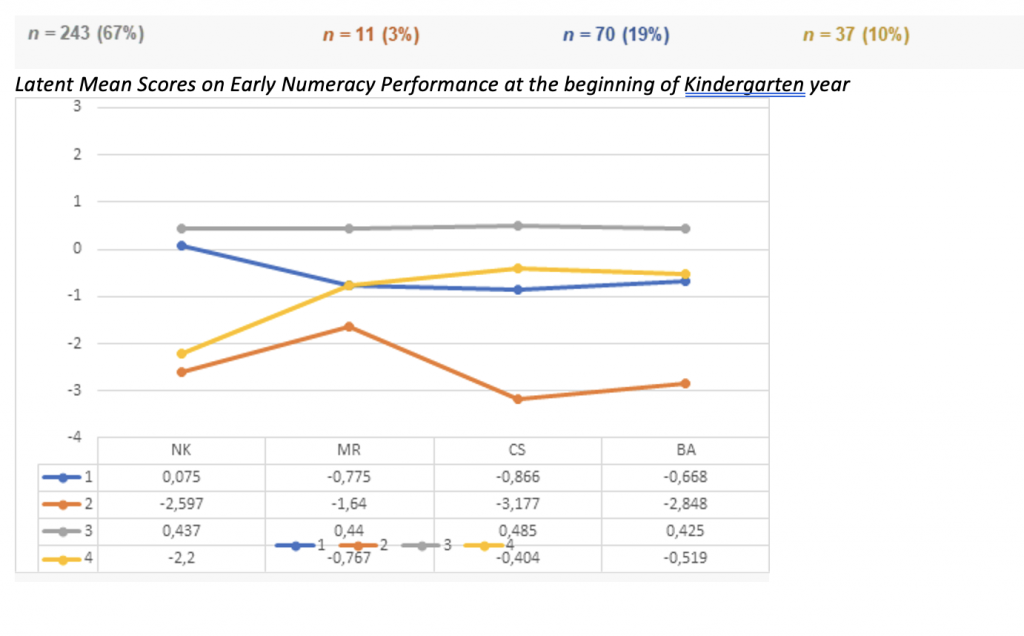JOIN EVENT
Session chair: Henrik Husberg
Paper 1: Individual differences in children’s early numeracy skills during a kindergarten year
Heidi Hellstrand, Faculty of Education and Welfare Studies, Åbo Akademi University, Vasa, heidi.hellstrand@abo.fi . Co-authors: Johan Korhonen, Pirjo Aunio
Abstract
Early numeracy (EN) skills have been determined to be vital for later learning in mathematics (Geary et al., 2018). There are large individual differences in children’s EN skills even before the start of formal education (Dyson et al., 2011). Early identification and support are highly important as children who do not develop foundational numerical skills in their early school years are at risk of encountering mathematical learning difficulties (Zhang et al., 2018).
This study aimed to examine individual differences in children’s EN skills during a kindergarten year. The study group consisted of 361 children (176 girls; Mage = 6.20, SD = 0.30) from 21 kindergarten groups in the Swedish-speaking areas of Finland. The children’s EN skills were measured at three time points during the kindergarten year (beginning, middle, and end) with the Early Numeracy test (EN-test) for screening and identifying children at risk for mathematics learning difficulties (Hellstrand et al, 2020; Koponen et al, 2011). The EN-test is based on the theoretical model of core numerical skills for learning mathematics in children aged 5 to 8 and focus on four skill groups: symbolic and non-symbolic number knowledge (NK), understanding mathematical relations (MR), counting skills (CS), and basic skills in arithmetic (BA) (Aunio & Räsänen, 2015).
Latent profile analysis identified four profiles with distinct EN-performance at the beginning of the kindergarten year: (1) children performing average in all four subskills (67%), (2) children performing average in NK and low in MR, CS and BA (19%), (3) children performing very low in NK and low in MR, CS and BA (10%), and (4) children performing very low in all four subskills (3%). There were significant differences in overall EN-performance between all profiles at the beginning of the kindergarten year, F (3, 357) = 399.385, p < .001, as well as in the subskills, except profile 2 and 3 in MR (p = 0.999) and BA (p = .933). However, the differences between the profiles in overall EN and in the subskills were non-significant in the middle, F (4, 299) = .851, p = .467, and in the end, F (4, 112) = .571, p = .635, of the kindergarten year. Age, gender, and language were not related to group belonging.
In the presentation the results are discussed in the context of assessment for identifying and supporting children at risk for learning difficulties in mathematics in early stage, and how systematic assessment can promote children’s mathematical learning and give equal opportunities for every child to develop sufficient early numeracy skills.

References
Aunio & Räsänen. (2015). Core numerical skills for learning arithmetic in children aged five to eight years – a working model for educators. European Early Childhood Education Research Journal, 24(5), 684-704.
Dyson, Jordan, & Glutting. (2011). A number sense intervention for low-income kindergartners at risk for mathematics difficulties. Journal of Learning Disabilities, 46(2), 166–181.
Geary, Nicolas, Li, & Sun. (2018). Domain-specific knowledge on mathematics achievement: An eight-year longitudinal study. Journal of Educational Psychology, 109(5), 680–693.
Hellstrand, Korhonen, Linnanmäki, Räsänen, & Aunio. (2020). Reliability and validity evidence of early numeracy test for identifying children at risk for mathematical learning difficulties. International Journal of Educational Research, 102, 101580.
Koponen, Salminen, Aunio, Polet, & Hellstrand. (2011). LukiMat – Bedömning av lärandet: Identifiering av stödbehov i matematik i förskola. Handbok. [LukiMat – Assessment for Learning: Identifying Children in Need of Support in Mathematics in Kindergarten. Handbook.] http://www.lukimat.fi/lukimat-bedomning-av-larandet/material/identifiering-av-stodbehov/forskola/f-mat-handbok
Zhang, Räsänen, Koponen, Aunola, Lerkkanen, & Nurmi. (2020). Early cognitive precursors of children’s mathematics learning disability and persistent low achievement: A 5‐year longitudinal study. Child Development, 91(1), 7–27.
Paper 2: The relationship between early numeracy skills and physical activity during preschool hours
Natalia Stalchenko, Faculty of Educational Sciences, University of Helsinki. Co-authors: Anssi Vanhala, Johan Korhonen, Pirjo Aunio
Abstract
Early numeracy (EN) skills are shown to strongly predict later academic achievements (Duncan et al., 2007). Thus, it is important to support the development of children’s EN skills. Several lines of evidence suggest the effectiveness of physical activity (PA) on children’s cognitive outcomes (Zeng et al., 2017), including early numeracy (Becker et al., 2014). However, previous research has mainly focused on school-age children and cross-sectional data (Donnelly et al., 2016), while research in early ages is scarce. No previous studies have used intensive longitudinal sensor data to understand dynamics in young children’s physical activity behaviour and EN performance.
The current study aims to investigate the relationship between PA during preschool hours and EN skills in children aged 3 – 5 years old. More specifically, we address the following research questions: 1) What kind of profiles regarding PA levels and EN skills can be identified among preschool aged children? 2) How is age related to the PA and EN profiles?
The sample consisted of children (N = 181) attending early childhood education centres in Helsinki, Finland. Physical activity was measured during five consecutive days using accelerometers (Actigraph wGT3X-BT) while the information regarding children’s preschool hours is obtained from parents’ diaries. Early numeracy skills were assessed using the Early Numeracy Test (Van Luit et al., 2006).
At the moment, data collection for the current sample is complete and the data cleaning is in progress. For the NORSMA10 conference, we will identify children’s profiles according to their PA data and EN test scores using latent profile analysis and examine the profile differences among age groups using ANOVA. Our study will produce scientific evidence of how variation in physical activity behaviour is related to early numeracy performance in preschool. The knowledge acquired from the findings related to preschool hours will be particularly useful to early childhood education teachers for supporting holistic development of preschool children.
References
Becker, D. R., McClelland, M. M., Loprinzi, P., & Trost, S. G. (2014). Physical Activity, Self-Regulation, and Early Academic Achievement in Preschool Children. Early Education and Development, 25(1), 56–70.
Donnelly, J. E., Hillman, C. H., Castelli, D., Etnier, J. L., Lee, S., Tomporowski, P., Lambourne, K., & Szabo-Reed, A. N. (2016). Physical Activity, Fitness, Cognitive Function, and Academic Achievement in Children: A Systematic Review. Medicine & Science in Sports & Exercise, 48(6), 1223–1224.
Duncan, G. J., Dowsett, C. J., Claessens, A., Magnuson, K., Huston, A. C., Klebanov, P., Pagani, L. S., Feinstein, L., Engel, M., Brooks-Gunn, J., Sexton, H., Duckworth, K., & Japel, C. (2007). School readiness and later achievement. Developmental Psychology, 43(6), 1428–1446.
Van Luit, J. E. H., Aunio, P., & Van De Rijt, B. (2006). Lukukäsitetesti (Early Numeracy Test).
Zeng, N., Ayyub, M., Wen, X., Xiang, P., & Gao, Z. (2017). Effects of Physical Activity on Motor Skills and Cognitive Development in Early Childhood: A Systematic Review. BioMed Research International, 2017, 2760716.
Paper 3: The association between executive functions and early numeracy in 4-year-old children
Molina Bustamante, University of Helsinki, Finland susana.molinabustamante@helsinki.fi
Co-authors: S., Vanhala, A. & Aunio, P.
Abstract
Later academic performance has been proven to be predicted by Early Numeracy (EN) skills (Duncan et al., 2007). Moreover, previous studies have found a positive correlation between Executive Functions (EF) and EN skills (Yang et al., 2019), suggesting that support of EF could benefit the development of EN skills, contributing to prevention of mathematical learning difficulties in some children. Executive functions have been found to predict early numeracy performance in the beginning of primary school (Bull & Lee, 2014), but we lack the evidence of the associations of executive functions and early numeracy in young children. To this concern, this study focuses on finding the relationship between Inhibition and Shifting (as EF) with EN skills of four years old children in Finland, (Helsinki Area). Therefore, the main research question of this study is articulated as: how is the existing relation between EF and EN in four-year-old children?
To understand the existing relation between EF and EN in four-year-old children, the current study is going to perform an analysis on the data that has been gathered by Professor Aunio (Active Early Numeracy, 2019). The test and data gathering was done To understand the existing relation between EF and EN in four-year-old children, the current study is going to perform an analysis on the data that has been gathered by Professor Aunio (Active Early Numeracy, 2019). The test and data gathering was done in two different dimensions. Students’ EN skills were measured with an analogic standardized Early Numeracy Test (described by Van Luit et al., 2006), whereas the EF were measured with a digital-based test (described by Lee et al., 2013). These last ones were measuring both accuracy and time response of the children, enabling the independent analysis of inhibition and shifting. The main aim of this study is to examine the relationship between inhibition and shifting (EF) in regard to children’s counting and number relation skills (EN performance), also considering the reaction time and accuracy of the participants’ responses. We will use regression analysis to find out how EF (inhibition and switching) are associated to EN (numerical relational and counting skills).
Therefore, the scientific relevance of our study is that we will produce meticulous (reaction time and accuracy) evidence concerning young children’s EF and its associations with early numeracy components (numerical relational and counting skills).
The practical implication is with our evidence we can find ways to support children with challenges in early numeracy learning.
References
Active Early Numeracy. (2019, October 15). University of Helsinki. https://www2.helsinki.fi/en/researchgroups/active-numeracy/projects/active- early-numeracy
Bull, R., & Lee, K. (2014). Executive Functioning and Mathematics Achievement. Child Development Perspectives, 8(1), 36–41. https://doi.org/10.1111/cdep.12059
Duncan, G. J., Dowsett, C. J., Claessens, A., Magnuson, K., Huston, A. C., Klebanov, P., Pagani, L. S., Feinstein, L., Engel, M., Brooks-Gunn, J., Sexton, H., Duckworth, K., & Japel, C. (2007). School readiness and later achievement. Developmental Psychology, 43(6), 1428–1446. https://doi.org/10.1037/0012- 1649.43.6.1428
Lee, K., Bull, R., & Ho, R. M. H. (2013). Developmental Changes in Executive Functioning. Child Development, 84(6), 1933–1953. https://doi.org/10.1111/cdev.12096
Van Luit, J. E. H., Aunio, P., & Van De Rijt, B. (2006). Lukukäsitetesti (Early Numeracy Test). https://researchportal.helsinki.fi/en/publications/lukuk%C3%A4sitetesti
Yang, X., Chung, K. K. H., & McBride, C. (2019). Longitudinal contributions of executive functioning and visual-spatial skills to mathematics learning in young Chinese children. Educational Psychology, 39(5), 678–704. https://doi.org/10.1080/01443410.2018.1546831
